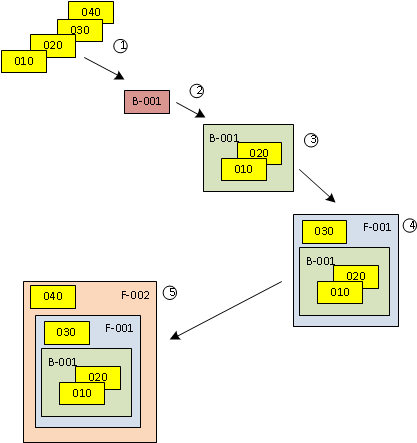Process for importing formulas with sub-formulas
A formula that contains sub-formulas must be imported in these stages:
- Import the raw material items.
- Create items, with no details, for sub-formulas. The sub-formulas are added as items to another formula. The item code must be the same as the formula that becomes the sub-formula at the next level. Include header data only; no details are required.
- Import formulas that are made up of only the raw materials from stage 1.
- Import formulas that are made up of raw materials from stage 1 and formulas from stage 3.
- Import formulas that may contain sub-formulas from stage
4. If this formula is not going to be a sub-formula, do not include an item code for it
in the header.

This example shows the stages of importing a sub-formula.
| Examples | Description |
|---|---|
010,
020,
030,
040
|
Import raw material items:
010,
020,
030, 040.
|
Item
B-001
|
Create items with a key code of
sub-formulas. Add header data only. Import a raw material
for |
Formula
B-001
Items
|
Import formulas (B-001) that
contain only raw material items (010,
020).
|
Formula
F-001
Sub-formula
Items
|
Import formulas (F-001) with sub-formulas (B-001)
from the previous level and items. The item code Include item
|
Formula
F-002
Item
Sub-formula
Item
Sub-formula
Item
|
Import formulas (F-002) with sub-formulas (F-001)
from the previous level and items. This formula is going to be used as an item
instead of a sub-formula. The item code |